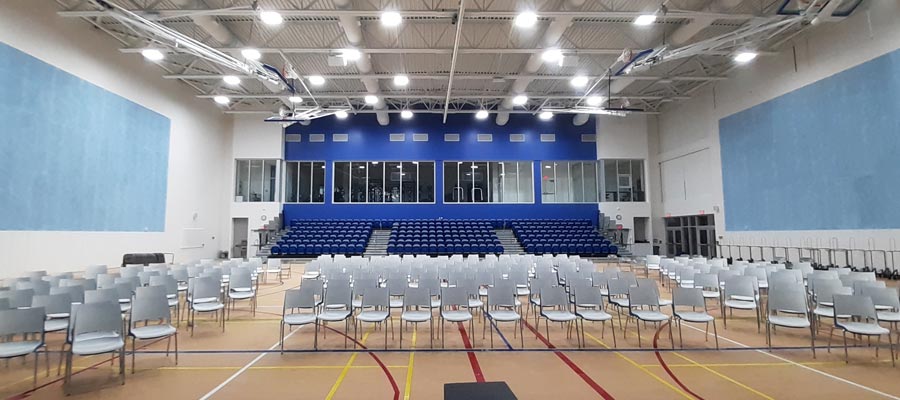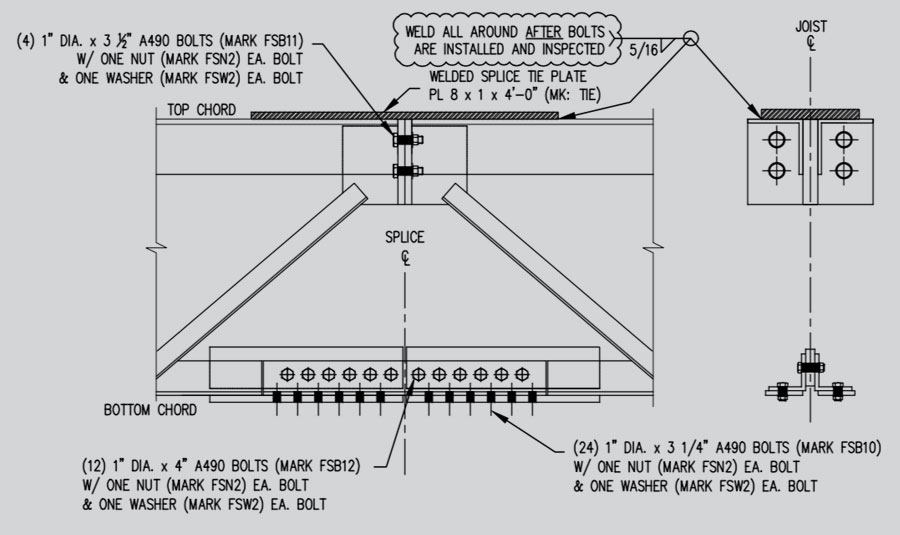
The island of Grand Cayman is a dream vacation destination featuring award-winning beaches, thriving nightlife and awe-inspiring natural attractions. But a growing mix of international residents call the island home. Billions of dollars have been poured into island developments. One of them is a U.S. $60 million expansion of the Cayman International School (CIS) that serves local and international students. While Grand Cayman is ideal for people who want to get away from it all, its location poses logistical and construction challenges for projects as significant as the CIS expansion.
A cornerstone of the CIS project is a multi-purpose gymnasium and performing arts center the school and community alike will use. The space accommodates multiple court configurations and a full theatrical stage. To create the expansive, unobstructed spans and open floor plan necessary for spectator sports and performances, the facility features nine 110-foot-long, 60-inch-deep, double-pitched steel joists and an acoustic steel roof deck.
Nearly every aspect of the gym’s design and construction is unique, from delivery of materials and their size to the products and building methods used. Project developer Dart, steel fabricator Charleston Steel, and New Millennium Building Systems worked closely together to ensure success from start to finish.
“You’ve got to do a lot of prep work,” said Christopher Mounts, manager of technical services at Charleston. “You’ve got to involve everybody up front and get everything preplanned so things flow smoothly.”
The CIS expansion did go relatively smoothly, but it was not without challenges.

Photo courtesy of Cayman International School
The versatile, expansive space can be used for theatrical performances and various sports.
Like one would do before visiting the Cayman Islands, extensive planning and collaborating took place before any double-pitched steel joists or steel roof deck panels began the 750-mile journey from Lake City, Florida, to Grand Cayman.
Gary Gibbs, senior vice president of design and construction at Dart, credited early cooperation between Charleston and New Millennium for successful shipping and delivery of 65 tons of steel to the 13-acre CIS campus. It’s a complicated process requiring stakeholders that understand how planning at the start of a project is key to a strong finish. Even before being placed on flatbed shipping trucks, for example, the erection plan and sequencing of the joists had to be finalized.
Because of their length, the nine 110-foot double-pitched steel joists were shipped as two 55-foot pieces, for a total of 18 pieces. Gibbs says delivery was complex.
The joists were shipped from the New Millennium plant in Lake City on inland freight to the Port of Miami, then they were placed on flat racks that are loaded onto ocean-going cargo vessels. It takes a week for them to arrive in Grand Cayman, where they are offloaded onto another flat rack. They are then transported via inland freight to the job site.
“That kind of journey can take three or four weeks,” Gibbs says. “If you miss a logistics window, it can definitely be a scheduling problem.”
New Millennium arranged special shipping for the joists. Standard shipping typically involves 40- or 45-foot cargo containers, too short for the 55-foot joist pieces. Adjusting to the length of the double-pitched joists became a recurring theme throughout the project.
“These are significant pieces of steel,” Mounts says. “All along the way, from shipping to erection, people were not used to steel pieces this size.”
Successfully getting building materials delivered did not end scheduling and timeline issues. In early 2020, the COVID-19 pandemic halted all project activity for three months, Gibbs says.
“Instead of finishing in August of 2020, we finished and obtained Certificate of Occupancy in November of 2020, allowing the school staff to move in and get ready for the January 2021 school term. This accomplishment is amazing considering we were completely shut down for three months and is a testament to the hard work and dedication of the entire project team” he says. “We managed to get this project finished within the original durations accounting for the COVID shutdown period.”
The school’s much-anticipated opening finally arrived Jan. 5, 2021.
Long-span joists of the size required for the gymnasium are not common on Grand Cayman. They were essential, however, to fulfilling the vision of Dart and CIS.
“We wanted a gymnasium that was open and versatile for different uses, from physical education classes to multiple court configurations for basketball and volleyball and badminton and other sports,” Gibbs says. “It’s a double gymnasium—a big gym for anywhere, but particularly for Cayman.”
“This project was exceptional due to the size of the joists,” Mounts says. “Even to me, they’re monstrous.”
As the biggest pieces of the project, the joists also were the biggest challenge—from design to erection.
Shipping restrictions necessitated the joists be manufactured in two pieces, then spliced on site, according to Ben Pitchford, engineering manager at New Millennium. The bolted splice was located at the ridge of the double-pitched joists.

Labeled a “welded splice tie plate” in this drawing, a solid plate was welded across the splice of the double-pitched joists to address high wind uplift.
To accommodate utilities and suspended elements, the joists’ bottom chords were engineered to address various integrated loads, including fire sprinklers; basketball goal structures; a dividing curtain; lighting; audio-visual equipment; and ducts.
“It was done in a flexible manner, so loads could be field-located as needed without additional reinforcement,” Pitchford says.
The joists also required further engineering to account for rooftop solar panel loads, Pitchford says, and a special design of the open webs for mechanical, electrical and plumbing passthroughs.
Additionally, the joist chords were designed to account for wind uplift. The school’s location in an area of the Caribbean Sea prone to hurricanes required engineering to accommodate a high magnitude wind uplift (60 pounds per square foot), along with axial wind loads in the joist top chord.
“This required the joists to be built with 5×5 angles for the top chord and 6×6 angles for the bottom chord,” Pitchford says.
High wind uplift also affected the splice joining the two halves of the double-pitched steel joists. The bolted splice at the top chord by itself was not adequate, so a solid plate was welded across the splice. Since the splice was at the ridge of the joists, the plate also had to be shaped to match the pitch of the joist at the top chord (see illustration above).

The gymnasium joists were engineered to accommodate various loads, including fire sprinklers, basketball goals, a dividing curtain, lighting, audio-visual equipment, and solar panels.
Joist erection was a major logistical undertaking, Mounts says. He coordinated sequencing and delivery closely with Pitchford to ensure everything went according to plan.
Once on site, the joists were spliced together on the ground, then carried onto the frame using a crane. Each end of the joists was welded to a horizontal steel embed plate atop the gymnasium’s concrete bearing walls.
Next, bridging was installed so joists would not roll on themselves, Gibbs says. The bridging was fairly large, Pitchford says, because the joists are placed 10’-0” on center. During this phase, the erectors ran into a problem.
“The erectors had set the joists up and were putting the bracing in, but the bracing wasn’t lining up properly,” says Mounts, who worked with Pitchford to diagnose the problem. “The X bracing and horizontal bracing had been placed in the wrong spots. Team members worked together to identify and resolve the issue quickly and without negative impact to the project.”
Hurricane season is busy on the Cayman Islands, with 85 hits or brushes with tropical storms or hurricanes from 1871 to 2019, according to University College Cayman Islands. In 2020, six tropical depressions, tropical storms or hurricanes affected the Cayman Islands, but none was severe. For that reason, design and construction adheres to South Florida-Miami-Dade hurricane standards. Concrete is the prevailing building material used to satisfy those standards, but that would not work with a project of this size.
“For long spans, steel is absolutely the way to go,” Gibbs says. “From a speed-of-construction standpoint, it is much quicker than forming a big concrete slab or a roof slab and eliminates the need for columns.”
“This gymnasium is one of the few roofs I’ve worked on that didn’t have concrete on it,” says Mounts, who has worked on projects in the area for 14 years. He adds that the island also is in a seismic zone, which dictated further design and engineering considerations.
Pitchford worked with the engineer of record early in the design phase to determine the ideal steel roof deck for the gymnasium. They settled on 3-inch type NA acoustical roof deck having two different gages.
“Considering requirements for high uplift and diaphragm shear, we had to use 18 gage deck at the perimeter of the roof to meet this need, then transitioned to 20 gage deck at the interior of the roof,” Pitchford says.
The acoustic option is common for gymnasiums, he says. The perforated steel deck has insulation in its cavities to help absorb and reduce noise bouncing off the underside of the deck.
Cayman International School students and Camana Bay community members are now using the gymnasium. It is an uplifting story that comes at just the right time.
“This Cayman International School managed by International Schools Services is one of the pillars of our town center,” Gibbs says. “It was important to us.”
“We love being involved in projects here, especially schools,” Mounts says. “We want to make sure we do our best job because we know it’s important for the community.”
“This project was satisfying on several levels,” Pitchford says. “We were able to overcome challenges with the help of invested project collaborators. We worked through a pandemic without losing much time. The result is a beautiful gymnasium and theater space for students and the community alike—and that makes you feel good.”

A recent $16.5 million addition at Rogers High School in Rogers, Arkansas, created a competition gymnasium that has the feel of a professional facility. To achieve the ambitious vision for Mountie Arena, 85-foot-long, 12-foot-deep double-pitched steel joists were used to create an expansive, arena-like feel.

The new home of the Texas Rangers in Arlington, Texas, features the biggest single-pane retractable roof in the world. On game days when the roof is closed, the steel roof deck making up the ceiling is custom-painted so players can more easily see—and catch—fly balls. See for yourself how it works.
Building a better steel experience